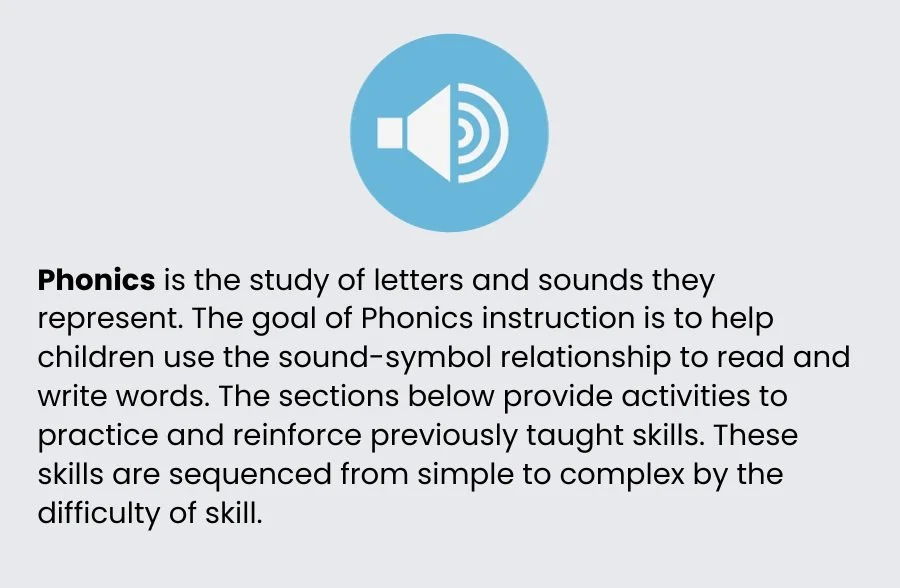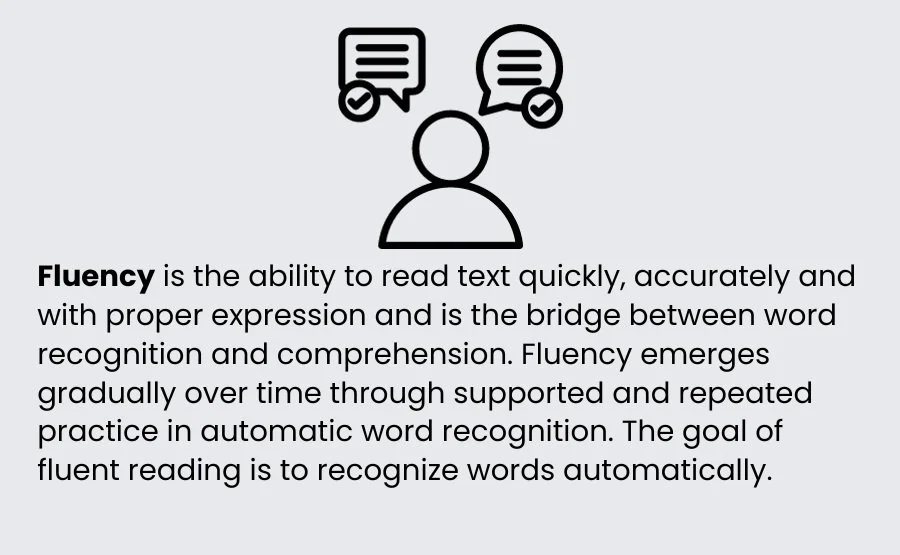Reading Comprehension
According to the Florida Center for Reading Research, there are five components of reading comprehension. Each of these components is interconnected, and a deficiency in one area can impact overall reading proficiency. Emphasizing the importance of these five components in reading instruction is vital for nurturing strong and competent readers who can navigate and comprehend a diverse array of texts across various subjects and contexts.
The Five Components to Reading Comprehension are : Phonological Awareness, Phonics, Fluency, Vocabulary and Comprehension
Phonological Awareness
Rhyme
One of the first skills of phonological awareness is the ability to identify words that rhyme with one another, or have the same ending. For example, asking a student if two words rhyme, or asking them to find a word that rhymes with another certain word. There are many fun activities that can be used to practice rhyming skills.
Create a rhyming book where students cut out pictures of rhyming words and glue them in the book.
Have students circle pictures of objects that rhyme, find objects around the classroom or their house that rhyme, or sort objects into groups that rhyme with one another. Teachers may also want to use picture books to teach this strategy.
Alliteration
Alliteration is when words have the same initial sound. One activity to do with young students is to have them think of a word that has the same initial sound as their first name such as Awesome Annie, Summertime Sarah, or Funny Frankie.Alliteration is when words have the same initial sound. One activity to do with young students is to have them think of a word that has the same initial sound as their first name such as Awesome Annie, Summertime Sarah, or Funny Frankie.
Sentence Segmentation
Separating the words of a sentence aloud to identify each word individually. Teaching to count how many words are in a sentence. Teaching children to repeat short sentences (3-4 words) and build to longer sentences (7-10 words) to teach children to recall words and phrases within a sentence.
Syllables
Syllabification is the ability to identify the number of syllables in spoken words. Students are asked to “clap out” the number of syllables as they say the word out loud, and are also able to identify how many syllables are in a word. Syllabification also includes identifying first, middle, and last syllables, blending syllables, and adding, deleting, and substituting syllables. Learning the process of dividing words into syllables, or parts, helps students learn how to decode words faster, and will have an impact on students’ reading fluency and the ability to spell words correctly.
Onset & Rime
The “onset” is the first phonological unit of a word, and the “rime” is the string of letters that follows it. For example, in the word “dog”, the “d” is the onset and the “og” is the rime. In the word “flat”, the “fl” is the onset and the “at” is the rime. Learning about onset and rimes helps children understand word families, and helps build a strong reading foundation.
Phonemes
Phonemes are the smallest unit of sound. Phoneme isolation, which is the ability to isolate or separate a single sound from the other sounds in a word.
Phonics
Letter Recognition
Letter learning has four components--letter recognition, letter naming, letter-sound knowledge, and letter writing. Letter recognition, also known as alphabet recognition, is the ability to identify letters by name, shape, and sound
Letter-Sound Correspondence
This is the understanding that every letter corresponds to a specific sound or set of specific sounds. It is relationship of the letters in the alphabet to the sounds they produce
Onset & Rime
Onset and rime are two parts of a word. The onset is the part of a single-syllable word before the vowel.The rime is the part of a word including the vowel and the letters that follows.
The rime is the first phonemes before the vowel (b in bat) followed by all the other phonemes (at in rat; esh in fresh). Words that share the same rime are considered rhyming words (e.g., fresh, mesh, flesh).
Word Study
The key to word study is focusing on word patterns, rather than memorization of a list of words. When kids learn word patterns, they’re able to construct and deconstruct words based on their parts.
Because word study focuses on word patterns, activities may differ from traditional spelling practice. Word Sorts are a really effective tool for word study because, by nature, they focus on word patterns!
Syllable Patterns
Closed: These syllables end in a consonant and the vowel is usually short. This is the most common type of syllable we see in English. Ex: rab–bit
Vowel + Consonant + E Syllables: These syllables have a long vowel and end with a silent e. Ex: cup-cake
Open Syllables: These syllables end in a vowel and the vowel is generally long. Ex: ro-bot
Vowel Team Syllables: These syllables are spelled with two vowels that are next to each other. Ex: tea-cup
R-Controlled: These syllables have a vowel followed by the letter r (er, ir, ur, ar, or). The letter r affects the vowel sound. These types of syllables can be difficult for students to master and will likely require continuous review. Ex: bur–ger
Consonant + LE: These syllables have a consonant followed by -le at the end of the word. If a C-le syllable is combined with an open syllable — as in cable, you do not double the consonant. If one is combined with a closed syllable — little — you double the consonant
Fluency
Letter Recognition
The student will gain speed and accuracy in letter recognition.
Letter-Sound Correspondence
The student will gain speed and accuracy in recognizing letter-sounds
High Frequency Words
High-frequency words are the words that appear most often in printed materials. Students are encouraged to recognize these words by sight, without having to “sound them out.”
Oral Reading
Fluency is defined as the ability to read with speed, accuracy, and proper expression. In order to understand what they read, children must be able to read fluently whether they are reading aloud or silently. Text or passage reading fluency is generally defined as having three components: accuracy, rate, and prosody (or expression).
Word Identification/Words in Context
By reading a text aloud, kids can listen to new words and learn how to pronounce them accurately. Additionally, hearing words in context helps readers understand word meanings more easily since they can focus on the word's use rather than its spelling or pronunciation
Words that Describe/Word Meaning
List of Best Preschool Vocabulary Words
Family members: mother, father, sister, brother, grandma, grandpa.
Body parts: hand, foot, head, eye, nose, mouth.
Feelings: happy, sad, angry, scared, excited, tired.
Word Categorization/Word Knowledge
Teaching vocabulary skills, specifically word categorization and word knowledge, to preschoolers can be done through a variety of engaging activities.
1. Sorting Games: Create sorting games where preschoolers categorize objects based on different criteria. For example, you can have pictures of animals, fruits, and vehicles.
2. Vocabulary Scavenger Hunts: Create a scavenger hunt where preschoolers search for specific objects in the classroom or outdoor environment that belong to a certain word category.
3. Word Wall: Establish a word wall in the classroom with different categories, such as animals, fruits, colors, or shapes.
4. Matching Games: Create matching games by providing picture cards with different categories.
5. Storytime and Discussions: During storytime, select books that introduce new vocabulary words related to different categories. After reading the story, engage the children in discussions about the story
Vocabulary
Comprehension
Sentence structure and meaning
Story Structure
Monitor for meaning
Main Idea/Summarizing
Activating and Connecting to Background Knowledge
Questioning
Visualizing and Inferring
Summarizing & Synthesizing Information









